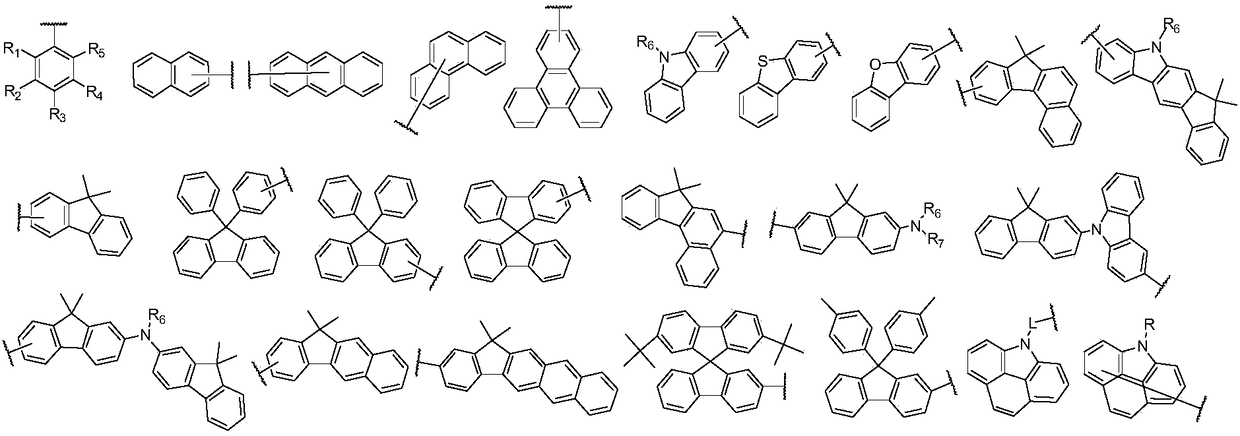OLED (organic light-emitting device)
An electroluminescent device, an organic technology, applied in the direction of electric solid-state devices, electrical components, luminescent materials, etc., can solve the problems of device performance degradation, shortened life, and device efficiency reduction, so as to reduce the driving voltage and improve production and utilization. , Improve the effect of compound rate
- Summary
- Abstract
- Description
- Claims
- Application Information
AI Technical Summary
Problems solved by technology
Method used
Image
Examples
preparation example Construction
[0108] The preparation of organic electroluminescent devices can be carried out in vacuum evaporation method, spin coating method, vapor deposition, blade coating method, laser thermal transfer printing, electrospray coating method, slit coating method and dip coating method. Any of them, the method of vacuum evaporation is preferably used in the present invention.
[0109] The organic light-emitting device of the present invention can be widely used in the fields of panel display, lighting source, flexible OLED, electronic paper, organic photoreceptor or organic thin film transistor, signboard, signal lamp and the like.
Embodiment 1
[0112] [Example 1] Synthesis of Compound 1-1
[0113]
[0114] Step1: Add benzidine-compound 1-1-f (1.35g, 8mmol), compound 1-1-g (1.55g, 6.67mmol), Pd in the reactor 2 (dba) 3 (0.17g, 0.2mmol), P(t-Bu) 3 (0.14, 0.67mmol), NaOt-Bu (2.24g, 20mmol), 100mL toluene solution, reacted at 100°C for 24h, extracted the organic phase with ether and water after the reaction, and used MgSO 4 Dry, concentrate the organic matter, go through column chromatography, and recrystallize to obtain intermediate 1-1-1 (1.61 g, 75%).
[0115] Step2: N-bromosuccinimide of compound 1-1-a (1.53g, 8mmol), (3.15g, 17.5mmol) and p-toluenesulfonic acid (0.5g, 2.7mmol) were added to the reactor and dissolved in In 30ml of acetonitrile, stirred at 50°C for about 12 hours. Cool to room temperature, depressurize, filter to collect crystals, and then wash with methanol to obtain compound 1-1-b. Take compound 1-1-b (1.80g, 6.67mmol) and methyl bromide 1-1-c (0.76g, 8mmol), add potassium tert-butoxide (2...
Embodiment 2
[0120] [Example 2] Synthesis of Compound 1-3
[0121] Compound 1-3 (3.86 g, 62%) was obtained according to the synthesis method of compound 1-1.
[0122] Mass Spectrum m / z: 741.32 (calculated: 741.31). Theoretical element content (%)C 55 h 39 N 3 : C, 89.04; H, 5.30; N, 5.68 Measured element content (%): C, 89.05; H, 5.30; N, 5.67. The above results confirmed that the obtained product was the target product.
PUM
 Login to View More
Login to View More Abstract
Description
Claims
Application Information
 Login to View More
Login to View More - R&D
- Intellectual Property
- Life Sciences
- Materials
- Tech Scout
- Unparalleled Data Quality
- Higher Quality Content
- 60% Fewer Hallucinations
Browse by: Latest US Patents, China's latest patents, Technical Efficacy Thesaurus, Application Domain, Technology Topic, Popular Technical Reports.
© 2025 PatSnap. All rights reserved.Legal|Privacy policy|Modern Slavery Act Transparency Statement|Sitemap|About US| Contact US: help@patsnap.com



